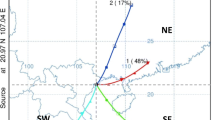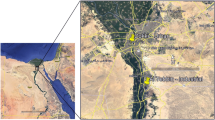Abstract
Source apportionment analysis was used to identify the factors contributing to atmospheric pollution at a monitoring location in the Southeast of Spain, a well documented area with an arid climate and high insolation favouring two sources of particulate matter: secondary transformation in the atmosphere and resuspension of crustal dry soils to the air. These conditions are further complicated by numerous industrial facilities in the area of the historical city of Cartagena. This paper describes the air quality of an area which includes a zinc metallurgical industry, a petrochemical factory, an oil power station, a shipyard and natural phenomena including African dust transport and resuspension of regional and/or local crustal materials. Major and trace element concentrations in PM10 and PM2.5 were determined at two monitoring stations in Cartagena (one PM10 sampler located at a traffic hotspot and the PM2.5 sampler at a suburban station), during 2004 and 2005. Results showed that in the PM10 fraction, the zinc metallurgical activity was linked to high levels of Cd, Zn and Pb; shipyard emission was associated with high levels of Cr and Ni; and high Ni and V levels were associated with the secondary aerosol indicating the contribution from oil combustion (oil-fired power station or petrochemical facilities). In the PM2.5 size fraction, the zinc source is defined by Zn and Pb; V, Ni and As appear with the oil combustion emissions. In contrast to PM10, shipyard activity is not consistently defined. Consistent sources found in both size fractions include crustal materials and traffic emissions.




Similar content being viewed by others
References
Alastuey, A., Querol, X., Castillo, S., Escudero, M., Ávila, A., Cuevas, E., et al. (2005). Characterisation of TSP and PM2.5 at Izaña and Sta. Cruz de Tenerife (Canary Islands, Spain) during a Saharan Dust Episode (July 2002). Atmospheric Environment, 39, 4715–4728.
Andreae, M. O., Andreae, T. W., Meyerdierks, D., & Thiel, C. (2003). Marine sulfur cycling and the atmospheric aerosol over the springtime North Atlantic. Chemosphere, 52, 1321–1343.
Bates, T. S., Quinn, P. K., Coffman, D. J., Jonson, J. E., & Middlebrook, A. M. (2005). Dominance of organic aerosols in the marine boundary layer over the Gulf of Maine during NEAQS 2002 and their role in aerosol light Scattering. Journal of Geophysical Research, 110, (D18202).
CAFE (Clean Air for Europe). (2004). Second Position Paper on PM, CAFE Programme. (European Comisión).
Canadian Chemical Producers’ Association. (2001). Ambient particulate matter characterization guidelines. Ottawa: Canadian Chemical Producers’ Association.
Capel Molina, J. J. (1986). El clima del territorio de Cartagena. In J. Mas Garcia (Ed.) Historia de Cartagena. Tomo I (pp. 171–192). Murcia: Ediciones Mediterráneo.
Cirera, L. (2005). Evaluación del plan operativo de intervención industrial sobre las emisiones atmosféricas de las fábricas urbanas y sus efectos en la morbimortalidad de Cartagena. Dissertation, University of Murcia.
Consejería de Sanidad de la Región de Murcia (1991). Contaminación atmosférica y salud en Cartagena. Monografías Sanitarias 10. (Cartagena).
Del Valle Alonso, J. L., Fernandez de Palencia y Roc, A., Rovira Pereira, A., Moreno Clavel, J., & Guzman Jiménez, R. (1970). Treatment of the leaching residues at the electrolytic zinc plant of Espanola del Zinc, S.A.. In C. H. Cotterill, & J. M. Cigan (Eds.) AIME World symposium on mining & metallurgy of lead & zinc, vol. II (pp. 348–388). New York: The American Institute of Mining, Metallurgical, and Petroleum Engineers.
Draxler, R. R., & Hess, G. D. (2004). Description of the HYSPLIT 4 modelling system. Retrieved March 2, 2005 from NOAA technical memorandum, ERL ARL-224 Web site: http://www.arl.noaa.gov/ready/hysplit4.html.
Eltayeb, M. A. H., Injuk, J., Maenhaut, W., & Van Grieten, R. E. (2001). Elemental composition of mineral aerosol generated from Sudan Sahara sand. Journal of Atmospheric Chemistry, 40, 247–273.
EPA (Environmental Protection Agency). (2006). 40 CFR Parts 53 and 58, Revisions to Ambient Air Monitoring Regulations, Final Rule. Retrieved November 20, 2006 from EPA Web site: http://www.epa.gov/ttn/amtic/files/ambient/pm25/pt535806.pdf.
Gangoiti, G., Millán, M. M., Salvador, R., & Mantilla, E. (2001). Long-range transport and re-circulation of pollutants in the western Mediterranean during the project Regional Cycles of Air Pollution in the West-Central Mediterranean Area. Atmospheric Environment, 35, 6267–6276.
Harrison, R. M., Smith, D. J. T., & Luhana, L. (1996). Source apportionment of atmospheric polycyclic aromatic hydrocarbons collected from an urban location in Birmingham, U.K. Environmental Science and Technology, 30, 825–832.
Hopke, P. K. (1992). Factor and correlation analysis of multivariate environmental data. In C. N. Hewit (Ed.) Methods of environmental data analysis (pp. 139–180). England: Elsevier Science.
Kallos, G., Kotroni, V., & Lagouvardos, K. (1997). The regional weather forecasting system SKIRON: An overview. Proceedings of the symposium on regional weather prediction on parallel computer environments, Retrieved February 23, 2004 from University of Athens Web site: http://forecast.uoa.gr/dustindx.html.
Kieber, R. J., Long, M. S., & Willey, J. D. (2005). Factors influencing nitrogen speciation in coastal rainwater. Journal of Atmospheric Chemistry, 52, 81–99.
Künzli, N., Mudway, I. S., Götschi, T., Shi, T., Kelly, F. J., Cook, S., et al. (2005). Comparison of oxidative properties, light absorbance, total and elemental mass concentration of ambient PM2.5 collected at 20 European sites. Environmental Health Perspectives, 114, 684–690.
Li, A., Jang, J. K., & Scheff, P. A. (2003). Application of EPA CMB8.2 Model for source apportionment of sediment PAHs in Lake Calumet, Chicago. Environmental Science and Technology, 37, 2958–2965.
Martínez García, M. J., Moreno-Grau, S., Martínez García, J. J., Moreno, J., Bayo, J., Guillén Pérez, J. J., et al. (2001). Distribution of the metals lead, cadmium, copper, and zinc in the top soil of Cartagena, Spain. Water, Air, and Soil Pollution, 131, 329–347.
McClain, C. R., Cleave, M. L., Feldman, G. C., Gregg, W. W., Hooker, S. B., & Kuring, N. (1998). Science quality SeaWiFS data for global biosphere research. Sea Technology, 39, 10–16.
Millán, M. M., Sanz, M. J., Salvador, R., & Mantilla, E. (2002). Atmospheric dynamics and ozone cycles related to nitrogen deposition in the western Mediterranean. Environmental Pollution, 118, 167–186.
Molnár, A., & Mészáros, E. (2001). On the relation between the size and chemical composition of aerosol particles and their optical properties. Atmospheric Environment, 35, 5053–5058.
Moreno-Grau, S. (2006). La vigilancia de la contaminación atmosférica: Pasado, presente y futuro. Cartagena: Academia de Farmacia Santa María de España de la Región de Murcia.
Moreno-Grau, S., Cascales-Pujalte, J. A., Martínez-García, M. J., Angosto, J. M., Moreno, J., Bayo, J., et al. (2002). Relationships between levels of lead, cadmium, zinc, and copper in soil and settleable particulate matter in Cartagena (Spain). Water, Air, and Soil Pollution, 137, 365–383.
Nickovic, S., Kallos, G., Papadopoulos, A., & Kakaliagou, O. (2001). A model for prediction of desert dust cycle in the atmosphere. Journal of Geophysical Research, 106, 18113–18129.
NRL (Naval Research Laboratory). (2003). Naval aerosol analysis and prediction systems, global aerosol model. Retrieved March 7, 2005 from NRL Web site: http://www.nrlmry.navy.mil/aerosol/index_shortcuts.html.
Pacyna, J. M. (1986). Emission factors of atmospheric elements. In J. O. Nriagu, & C. I. Davidson (Eds.) Toxic metals in the atmosphere (pp. 33–52). London: Wiley.
Perraudin, E., Budzinski, H., & Villenave, E. (2005). Kinetic study of the reactions of NO2 with polycyclic aromatic hydrocarbons adsorbed on silica particles. Atmospheric Environment, 39, 6557–6567.
Querol, X., Alastuey, A., Chaves, A., Spiro, B., Plana, F., & Lopez-Soler, A. (2000). Sources of natural and anthropogenic sulphur around the Teruel power station, NE Spain. Inferences from sulphur isotope geochemistry. Atmospheric Environment, 34, 333–345.
Querol, X., Alastuey, A., Rodríguez, S., Plana, F., Mantilla, E., & Ruiz, C. R. (2001b). Monitoring of PM10 and PM2.5 around primary anthropogenic emission sources. Atmospheric Environment, 35, 845–858.
Querol, X., Alastuey, A., Rodriguez, S., Plana, F., Ruiz, C. R., Cots, N., et al. (2001a). PM10 and PM2.5 source apportionment in the Barcelona Metropolitan area, Catalonia, Spain. Atmospheric Environment, 35, 6407–6419.
Querol, X., Alastuey, A., Rodríguez, S., Viana, M. M., Artıñano, B., Salvador, P., et al. (2004a). Levels of particulate matter in rural, urban and industrial sites in Spain. Science of the Total Environment, 334–335, 359–376.
Querol, X., Alastuey, A., Viana, M. M., Rodríguez, S., Artiñano, B., Salvador, P., et al. (2004b). Speciation and origin of PM10 and PM2.5 in Spain. Journal of Aerosol Science, 35, 1151–1172.
Reis, M. A., Oliveira, O. R., Alves, L. C., Rita, E. M. C., Rodríguez, F., Fialho, P., et al. (2002). Comparison of continental Portugal and Azores Islands aerosol during a Sahara dust storm. Nuclear Instruments and Methods in Physics Research B, 189, 272–278.
Salvador, P., Artiñano, B., Alonso, D. G., Querol, X., & Alastuey, A. (2004). Identification and characterisation of sources of PM10 in Madrid (Spain) by statistical methods. Atmospheric Environment, 38, 435–447.
Sternbeck, J., Sjödin, A., & Andréasson, K. (2002). Metal emissions from road traffic and the influence of resuspension—results from two tunnel studies. Atmospheric Environment, 36, 4735–4744.
Tanner, P. A., & Wong, A. Y. S. (2000). Soluble trace metals and major ionic species in the bulk deposition and atmosphere of Hong Kong. Water, Air, and Soil Pollution, 122, 261–279.
Thurston, G. D., & Spengler, J. D. (1985). A quantitative assessment of source contributions to inhalable particulate matter pollution in Metropolitan Boston. Atmospheric Environment, 19, 9–25.
Turpin, B. J., Saxena, P., & Andrews, E. (2000). Measuring and simulating particulate organics in the atmosphere: problems and prospects. Atmospheric Environment, 34, 2983–3013.
US Department of the Navy. (1996). Impact of recent and anticipated changes in airborne emission exposure limits on shipyard workers. The National Shipbuilding Research Program. Report No. NSRP 0463.
Viana, M., Querol, X., & Alastuey, A. (2006). Chemical characterisation of PM episodes in NE Spain. Chemosphere, 62, 947–956.
Viana, M., Querol, X., Alastuey, A., Cuevas, E., & Rodríguez, S. (2002). Influence of African dust on the levels of atmospheric particulates in the Canary Islands air quality network. Atmospheric Environment, 36, 5861–5875.
Wåhlin, P., Berkowicz, R., & Palmgren, F. (2006). Characterisation of traffic-generated particulate matter in Copenhagen. Atmospheric Environment, 40, 2151–2159.
Acknowledgements
This study was supported by research projects from the D.G. Environmental Quality and Assessment from the Spanish Ministry of the Environment and the Plan Nacional de I+D from the Spanish Ministry of Education and Science (CGL2004-05984_C07-02/CLI, REN2001-0659-C03-03, REN2003-01997). Financial support was also provided by the Spanish Ministry of Education and Science through a “FPU” grant to Luis Negral.
Author information
Authors and Affiliations
Corresponding author
Rights and permissions
About this article
Cite this article
Negral, L., Moreno-Grau, S., Moreno, J. et al. Natural and Anthropogenic Contributions to PM10 and PM2.5 in an Urban Area in the Western Mediterranean Coast. Water Air Soil Pollut 192, 227–238 (2008). https://doi.org/10.1007/s11270-008-9650-y
Received:
Accepted:
Published:
Issue Date:
DOI: https://doi.org/10.1007/s11270-008-9650-y




